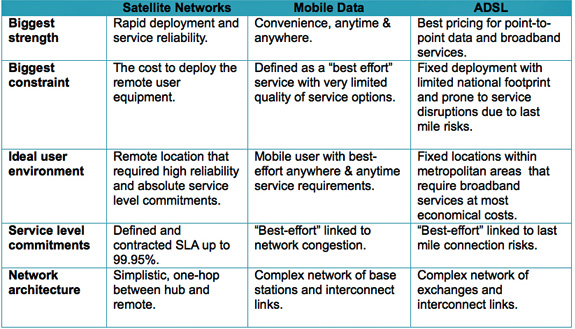If 54 million people in Africa use 3G for data connectivity, and three million people use ADSL, and less than 500,000 people use satellite, does this mean 3G is the best option for broadband Internet access services? Is the number of subscribers indicative of performance, marketing excellence—or both?

When marketing messages, pricing policies and technology advantages are blurred, then it is rather difficult to differentiate the principles and what service will be best for a particular application. Within this situation in which it seems that providers are actively collaborating to disguise the fundamentals, having our own reference of the fundamental principles will certainly help.
This discussion provides a principle understanding to equip subscribers, managers and network architects with an appreciation of the intrinsic difference between these technologies. A point-by-point comparison is not made between the technologies—to do so would be counter to the main message of this discussion: That each technology is quite different, each has a core focused application area and are not really alternatives for one another.
To start the discussion, let us consider some examples, hypothesises and paradigm-shifting thoughts.
DStv (Digital Satellite Television) is vastly successful in Africa and implemented using satellite communications channels. North America’s television industry was established using cable TV networks and, given the rapid rollout of fiber networks in Africa, is it fair to assume that DStv will soon migrate to a cabled technology? If fibre, as a cable technology, is faster and cheaper than satellite, why not migrate DStv to fiber networks? Yet, we haven’t heard any discussions that indicate fibre networks could be considered as a means to broadcast DStv channels.
This is because satellite networks are ideal for broadcast services, i.e., services where the same content is distributed from a single point to many remote locations as applicable to television broadcast, digital media, educational content distribution, and more.
Once we understand this fundamental characteristic of satellite networks, we will be able to make decisions based on solid references and not on specific product offerings.
Next, let us consider public broadband access networks or mobile data networks that are used by 6.4 million subscribers in South Africa, as opposed to only 875, 000 subscribers that use ADSL as a broadband access option. Surely, six million users cannot be wrong! 3G must be the better option. In this case we define “better” from a user perspective, meaning faster, cheaper and more reliable.
When we look at the specific pricing and compare 3G with ADSL, then 3G actually compares poorly to ADSL. Furthermore, mobile data networks are actually “best effort” services and not generally offered with a committed minimum service level.
Taking this into consideration, 3G has lost the factual comparison, yet has the lead in market acceptance. This is one example that effectively illustrates that mass deployment or mass acceptance of technology could be for the wrong reasons and not because the technology is fundamentally better.
Buying decisions are not based on pure technology criteria and, more often than not, they are influenced by some past experience, interaction with a specific service provider, or general market perception (a more serious issue).
Business is an integrated domain of technology, relationships, service delivery, pricing and much more—it would be futile to try to explain all these intricacies.

Rather, we will focus on providing a general understanding of the principles of each of these technologies so that users and network architects can align technology principles with requirements and then add all the other considerations.
First, we consider ADSL networks. South Africa and most countries across Africa operate on a fixed line infrastructure that is provided by public network operators. The service is implemented using either copper cable networks, or in very limited areas, fiber distribution networks.
In South Africa, the service is implemented over Telkom’s infrastructure and is defined in terms of the expected data rates with no further service level definition or commitment. ADSL can only be offered in areas with digital exchanges and also when the subscriber premises are within a limited range from digital exchanges.
ADSL services are implemented over point-to-point circuits from the customer premises, through Telkom’s network, to the data center of the head office. Even national customer networks are implemented using this “circuit” philosophy and are comprised of multiple, integrated, point-to-point links.
3G (or other mobile data) services, initially developed as a data connectivity solution for individual users, are offered using mobile network infrastructure and is available throughout South Africa. The phenomenal success of mobile network operators has resulted in this service being made effectively available “anytime and everywhere.”
The success of the 3G networks has also led to the use of 3G services for corporate data connectivity applications, such as bank ATM networks, office connectivity, remote data collection, and much more. However, with the mass adaptation of 3G data connectivity services and the increase in GSM network traffic, network congestion has become more of a hindrance and limitation and more so because the “best effort” nature of this service is part of the principle technology characteristics.
Satellite networks (except for the latest Ka-band deployments) are available anywhere and anytime. These networks are developed with extremely high availability and reliability. Have you ever wondered what would happen if the national television broadcast is distributed on a “best effort” basis? Satellite networks are perfectly positioned for broadcast application and, remember, distribution of IP content is just another format of broadcasting (technically referred to as multicasting).
While this is not an in-depth analysis of each technology, it does strive to communicate a better understanding of the satellite vs 3G vs ADSL to guide users and network architects.
The key technology differentiation points are summarized in Table 1, above, with the principles noted as follow:
— Satellite networks provide “anywhere and anytime” communication at extremely high availability and is perfect for broadcast applications, including data broadcast
— ADSL and cables networks are the cost leaders for services to fixed locations within metropolitan areas and where available
— 3G and mobile data services are the ultimate in convenience and ease of deployment yet limited by a “best-effort” service level commitment for enterprise applications
For additional information about Q-KON, access their website at: http://qkon.com/

About the author
Dr. Dawie de Wet (PhD Eng) is the Chief Executive Officer of Q-KON Africa and Chairman of the Group. He has more than 24 years of experience in the design, development and implementation of Wireless, Microwave and Satellite communication systems in Africa. In 1988 he joined the Q-KON board and was appointed Managing Director in 1993. In 2013, Dawie completed his Ph.D. in Engineering. His thesis titled: A scalable business model for mass customization of broadband services in the emerging Africa market summarised the result of seven years of research work focused on the value proposition of the domain where technology, business and market domains intersect. The research work provides both Dawie and Q-KON with a sound reference and foundation to meet current and future market demands in challenging landscapes.
About Q-KON
Q-KON is a South African based engineering group that provides turn-key solutions and managed network services to the African and South African telecommunications industries. The company focuses on the delivery of innovative wireless, satellite and VoIP (Voice over IP) solutions. This technology is expertly designed to meet increasing demands for connectivity and enhanced telecommunications capabilities within these developing economies. For 23 years, Q-KON has followed successful strategies to establish advance technologies in challenging environments to unlock real business benefits for all. Since its inception, the company has distinguished itself in the solutions and services it provides and has conquered many business impossibilities. Q-KON’s engineering achievements throughout its target markets are underwritten by sound business practices and long-term ethical relationships.

